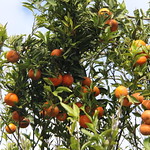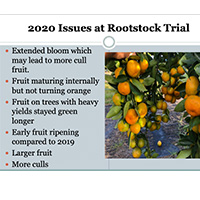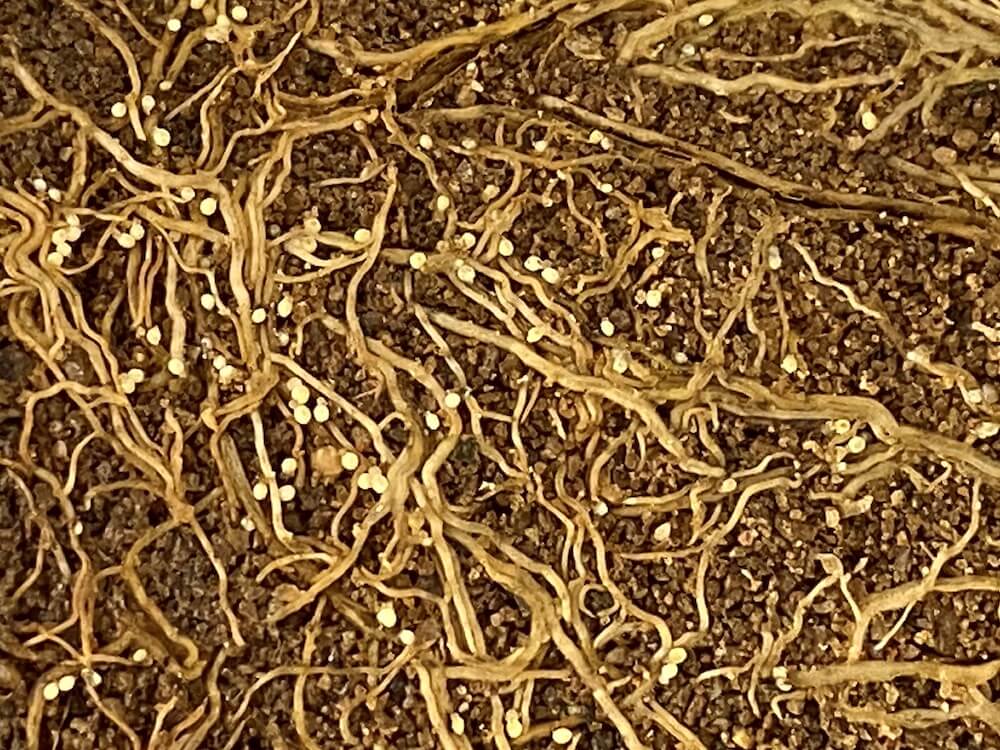Ongoing citrus rootstock trials being conducted by University of Georgia Cooperative Extension in Lowndes County hold promise for increased yields, improved fruit quality and greater disease resistance.
Jake Price, UGA Extension agent and Lowndes County Extension coordinator, has produced six local citrus rootstock/variety trials with varying objectives. These trees are custom-produced by U.S. Department of Agriculture-certified citrus nurseries in Florida according to Price’s specifications.
Many citrus varieties that emerge from seed are identical to the parent tree, but their root systems are usually more susceptible to insects and diseases compared to trees grafted onto a rootstock. Combining the desired citrus variety on a superior citrus rootstock can impart qualities that improve the tree.
“There are citrus varieties that have superior root systems, but their fruit is poor quality. If you take that superior root system that has resistance to insects and disease, then graft a scion of the citrus variety you want, it will produce a superior tree,” Price said.
Ongoing citrus trials
The oldest trial, planted in 2014, is growing ‘Owari’ satsuma trees on 10 standard and new trifoliate hybrid rootstocks. A trifoliate hybrid rootstock is a cross between a variety called Poncirus trifoliata crossed with another type of citrus. Poncirus trifoliate is often used in rootstock crosses because it has desirable qualities including pest and disease resistance. Rootstocks being evaluated are ‘US-942’, ‘US-897’, ‘US-852’, ‘US-812’, ‘X-639’, ‘Kuharski Carrizo’, ‘Swingle, ‘Cleopatra’, ‘Sour Orange’ and ‘Rubidoux’.
The goal of this trial is to evaluate how ‘Owari’ satsuma performs on these rootstocks to give growers more rootstock options. Currently most citrus in Georgia is grown on Poncirus trifoliata rootstocks such as ‘Rubidoux’, ‘Rich 16-6’, or ‘Flying Dragon’. The trifoliate hybrid rootstocks being tested — with the prefix US — were developed by Kim Bowman, rootstock geneticist of the USDA’s Agricultural Research Service (USDA-ARS) in Ft. Pierce, Florida. Data has been collected each year as the trees mature to show how each of these rootstocks perform with ‘Owari’ satsuma.
Trial No. 2, planted in 2016, is examining early maturing satsuma varieties on ‘Rubidoux’ rootstock. Trial No. 3, planted in 2018, is examining two satsuma/changsha hybrids called ‘Orange Frost‘ and ‘Artic Frost‘. Trial No. 4, planted in 2018, is testing the ‘Sugar Belle’ mandarin on four rootstocks. Trials No. 5 and 6, planted in 2020, will evaluate ‘Silverhill’ satsuma and ‘Tango’ mandarin on newly released rootstocks that have tolerance to citrus greening disease, also known as Huanglongbing (HLB), which has devastated millions of acres of citrus crops throughout the U.S. and abroad.
Traditionally, satsuma mandarin has been grown primarily on Poncirus trifoliata rootstocks such as ‘Flying Dragon’, ‘Rich 16-6’ and ‘Rubidoux’. These trials will determine how newly developed citrus rootstocks effect different varieties in terms of tree yield, fruit quality, disease resistance, tree size and cold hardiness. ‘Rubidoux’ rootstock is being used in the trials to compare with a number of other hybrid rootstocks developed by the USDA and the University of Florida. Many of these rootstocks have shown tolerance to HLB.
“Many of these rootstocks being evaluated have never been evaluated on satsumas anywhere,” said Price. “By performing these trials, we will see how some of the varieties of citrus we grow in Georgia perform on these newer rootstocks. If HLB becomes a problem in Georgia, we will have data on how Georgia-grown satsumas and tangos perform on the newer HLB-tolerant rootstocks.”
Promising results
All of the trees in the rootstock and variety trials have survived the state’s winters thus far. The data collected on yield, fruit quality, tree size and hardiness over the course of years will provide important guidance for growers to continue to advance the growing citrus industry in Georgia. As of now growers are speculating about how some of these rootstocks and varieties will perform in Georgia.
Data collected in 2020 from the ‘Owari’ trial showed that trees on the rootstocks ‘X-639‘, ‘Kuharski Carrizo‘, ‘Cleopatra‘ and ‘Sour Orange‘ produced less fruit in 2020 than 2019, indicating that these trees may alternate bear, or produce greater than average yield one year and lower than average the next. Rootstocks ‘US-942’, ‘US-897’ and ‘US-852’ produced significant yield increases over the previous year and have yet to alternate bear. Thus far, ’Owari’ trees grafted onto ’US-942’ have produced the most yield in the ‘Owari’ trial.
The 2020 crop also showed that fruit took longer to turn orange on rootstocks with heavy fruit loads, including ’US-942’, ’US-897’, ’US-852’ and ’Rubidoux’. This can be a problem when marketing the fruit, Price said, however each growing season is different, so multiple years of data are needed to draw conclusions.
All of the rootstocks produced a higher percentage of cull fruit from the previous year. Many factors may contribute to more cull fruit, from weather conditions to fertility. Cull fruit is considered fruit that isn’t marketable due to abnormal size, severe blemishes, puffiness or sunburn.
Rootstocks also influence tree size. Large trees present more harvest challenges than smaller trees,” Price said.
“For example, ‘Owari‘ grafted onto ‘X-639‘ may be twice as large as 'Owari' grafted onto ‘US-897‘. If you have 100 pounds of fruit on a small tree and 100 pounds on a large tree of the same age, that affects the yield efficiency of the tree. The smaller tree will have a greater yield efficiency. With the size of the tree, larger doesn’t necessarily mean better — it is easier to harvest from the smaller tree that a larger tree,” Price said.
Expanding the industry
There are hundreds of varieties and rootstocks available in the citrus industry, including hybrids which are constantly being developed by researchers crossing different varieties seeking improved rootstock qualities.
“Hopefully our data will help new growers decide what rootstocks they want to use when they are planting their groves,” Price said.
Since it launched in 2013 and 2014, south Georgia’s citrus industry has grown to about 2,000 acres of commercial citrus planted primarily of cold-hardy satsumas, Price said.
The ‘Owari’ rootstock trial has been supported by Langdale Corp., The Irrigation Store, Lowndes County Farm Bureau, Dasher Services, Loch Laurel Nursery and Hahira Nursery.
For more information on citrus rootstocks, visit citrusrootstocks.org. More information on UGA citrus research is available on the UGA Citrus Blog.








